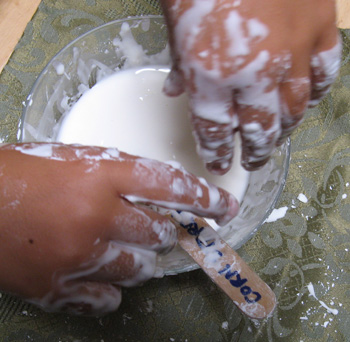
One afternoon, the Free-Ride offspring were in the mood for some spur of the moment experimentation.
So, we cleared the kitchen table, rummaged through the cupboards, and came up with a plan.
The question we decided to investigate:
What happens to different dry ingredients when you add water to them?
We put each of the dry ingredients in its own little bowl. (If they got mixed up, that would make it harder to figure out what was going on.) Also, to help us remember what was in each bowl, we labeled the wooden sticks that we used to stir once the water was added.
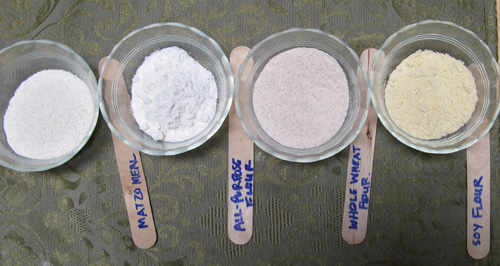


The dry ingredients we used were matzo meal, all purpose flour, whole wheat flour, soy flour, baking soda, salt, cocoa powder, and corn starch. We pretty much went with what we could find in the cupboards, but I made a point of finding the salt, the baking soda, and the corn starch.
We used tap water, and didn’t measure it at all precisely. Our main goal was to get each dry ingredient really wet without overflowing the bowls they were in.

The sprogs started with the table salt. When they added water and stirred, “the amount of salt is less,” says the younger offspring.
“It’s not actually disappearing,” remarked the elder offspring. “It’s dissolving in the water.”
Stirring made more of the salt disappear, although we didn’t get to a completely clear solution. Probably this means we had an excess of salt for the amount of water we could fit in the bowl without spilling, at least at room temperature. (Actually, “room temperature” when we did this was about 85 oF.)
The stuff that looked like water tasted salty, more evidence that the salt hadn’t been zapped into oblivion.
The baking soda also dissolved in water (although the taste of the resulting solution was pronounced “really bad” by both sprogs). Unlike the salt, however, the baking soda bubbled a little as we stirred the water in.
“You can make a volcano with baking soda and vinegar,” noted the elder offspring.
“Do the bubbles mean that water is kind of like vinegar?” asked the younger offspring.
Hmmm.
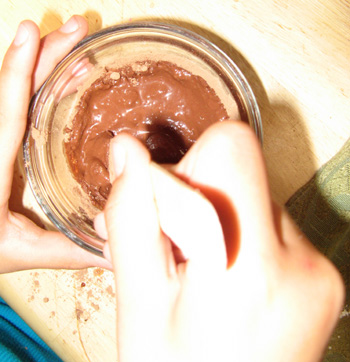
We then moved on to the floury ingredients.
Add the water was added, the all purpose flour started out sort of lumpy. With more stirring, though, the lumps went away.
“The flour’s not going away like the salt did,” observed the younger offspring.
“No, it’s getting to be like a paste,” replied the elder offspring.
“Do you know that when I was I kid we used to make paste from flour and water?” I asked.
The sprogs rolled their eyes.
Adding water to the whole wheat flour made a paste with a slightly grittier texture. (More fiber!)
Adding water to the cocoa produced a cocoa colored paste.
“It looks like chocolate sauce!” cried the younger offspring.
It did not taste like chocolate sauce. (Doing experiments in which all of the ingredients are safe to taste ensures safety, but not deliciousness.)

By the time we got to the soy flour, we expected that it would make a paste rather than dissolving. And it did, but it surprised us by making bubbles.
“The baking soda did that, too,” said the elder offspring, “but the soy flour doesn’t taste anything like the baking soda.”
We’re not entirely sure where the bubbles came from, but we may be mixing soy flour with vinegar at some later date, just to see what happens.
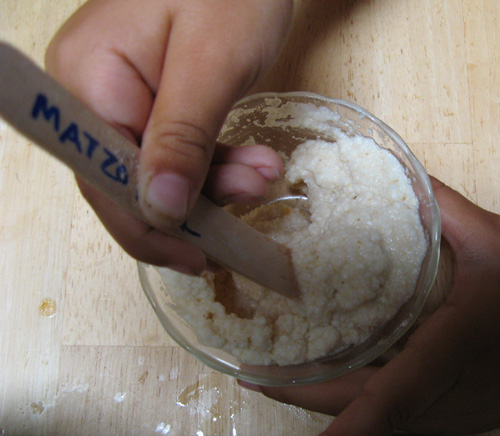
The matzo meal didn’t really make a paste so much as a porridge-like substance. The younger offspring pronounced it tasty.
Finally, we got to the corn starch.
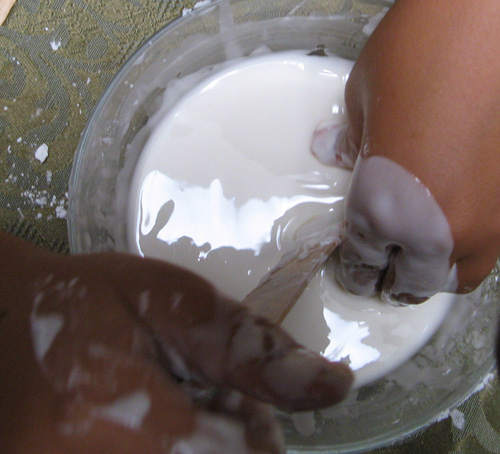
We added the water gradually with vigorous stirring. In fact, at first we overshot and added too much water, which gave us a cloudy white liquid. So, we added more cornstarch and stirred some more.
At which point we achieved oobleck!
We did not go into a long discussion of the theoretical basis for non-Newtonian fluids. Rather, we squished around in it to see how it behaved.
“I love this!” squealed the younger offspring. “If you squeeze it hard you can pick it up like a snowball, but if you stop squeezing, it melts back into the bowl.” The younger offspring spent a good half hour in the oobleck, moving fast and moving slowly, poking gently and pushing hard.
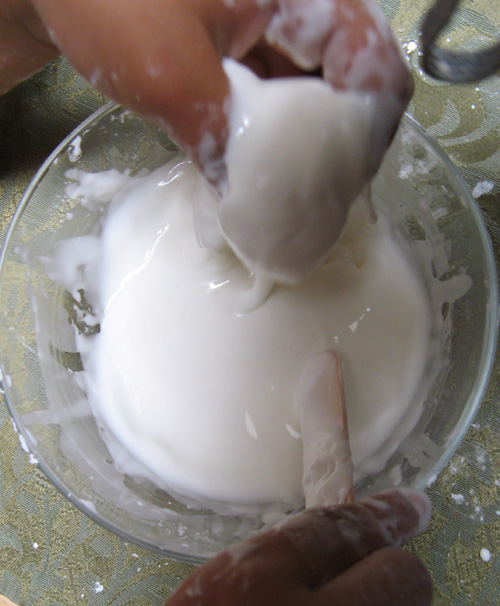
I did not show either of the sprogs this video. We don’t have a pool, and we’re not planning to get one. (Nor are we going to fill our bathtub with oobleck, thank you very much.)
A few days later, we tried to make oobleck with potato starch. It worked just as well as corn starch, but, according to the younger offspring, tastes better.

haha. awesome. This took me right back to when me and my sister used to do Friday afternoon baking with my mum. Half the excitement was watching what all the stuff turned into. Baking bread was my favourite, apparently i would sit in front of the oven (which had a clear see-through front) and just watch the stuff rising. It was like magic.
Why is it called oobleck?
Noticed how all your powders are white (except cacao).
Reminds me of the time my son wanted to compete in one of these high school science contests where you have to package an egg in one of the old L’eggs pantyhose containers and then drop it from a height without breaking the egg. Points are given for low time of descent and for light weight. A few weeks previously I had been showing the lad (and his sister) the wonders of non-Newtonian fluids including tomato soup.
Offspring One realized that an egg was really incredibly strong so long as it was in perfectly even compression. When a cornstarch paste “solidifies” on impact the stress on the egg in the middle is uniform.
Which led directly to taking the L’egg container, filling it with an egg and cornstarch paste (oobleck, you called it; why?), and taping it securely together with duct tape. Dropped it off the deck of the house; untaped it, poured out the mess, and there was one unbroken fresh egg! Tried again from higher up. Same result.
Offspring Two was impressed. Mom was more impressed.
He won on descent speed, but the scoring formula was weighted to light weight designs, so he didn’t win over all. But all of you out there in Sprogland might keep it in mind as a really surprising way to do well in the egg drop contest of the future. Oh, the plastic shell cracked when it was dropped for real in competition.
Curse my cranky old fart memory, but I can’t recall what baking soda is made of. I do remember that water acts as a mild acid, so the bubbles are the product of a chemical reaction.
You and the Tax Deductions find any interesting recipes involving corn meal, flour, baking soda, and water be sure to post them here in your blog.
We made oobleck at school last spring during Dr. Suess week (we read the story first). The kids loved it, but we weren’t as prepared for the mess it made as we should have been. We added food coloring, which I wouldn’t do again. We should have let the kids make it in a big bowl, instead of doing individual batches. I think that’s what we’ll do this year- if they let me volunteer to do it again!
awesome video! and what a fun experiment 🙂
if they want to learn more about vinegar and acid/base chemistry, I suggest baking! I make this delicious vegan cake, and it calls for vinegar (for the rising). I made it once and disliked the aftertaste, so I started subbing in lemon juice. When I want to change the flavor of the cake, I use different types of acidic juices (and I look up the pH to see if I have to adjust the amount). The vegan cake is a lot of fun because I’ve learned a lot about subbing out different ingredients in baking.
“Oobleck” comes from the early Dr. Suess story, “Bartholomew and the Oobleck.” In this story, the king becomes with the four things that come from the sky (rain, snow, fog, and sun), and his magicians come up with “oobleck.” It is viscous, slimy green stuff, which sticks to everything and everyone, threatening the kingdom, until Bartholomew saves them all.
I always imagined “oobleck” to be more like a polymer solution (think of traditional Hollywood slime, like in Ghostbusters) than a shear-thickening cornstarch paste. Both are non-Newtonian, but in different ways.
Complex fluids are so cool!
Just to elaborate on Kelly Miller’s story, the use of Suess’ word “oobleck” for corn-starch paste made its way into wide usage via SF fandom and various hi-jinks at cons.
I remember one con where they had it in the sink at a part, and someone accidentally punched the room’s sink out of it’s countertop. (hitting a big batch of it is another demonstration of its oddities…) Due to an abundance of engineering types, by the end of the con, they’d put the sink back with sturdier fastenings. Another time, the same crowd filled a bathtub with it, and eventually discovered that disposing of that much oobleck is not so easy!
Pingback: Help high school “nerds” visit the Large Hadron Collider. | Adventures in Ethics and Science